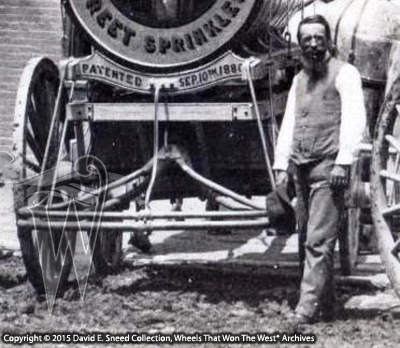Permeating the American landscape, horse drawn vehicles weremanufactured by the millions in the 18 and early 1900’s. Cities were especially packed with a varietyof designs. From ambulances and coalwagons to ice, petroleum, furniture, milk, bakery, express, grocery, mail,meat, peddler, sanitation, farm, freight, lumber, and even dray wagons, thecountry’s city streets were once home to an enormous variety of spring-hung anddead-axle wagons. With such great diversity,it can be tough these days to gather details on all of the makers andstyles.
While some were built for a precise function, others were used for amultitude of purposes. One of the moreclear-cut designs was the “Sprinkler wagon.” Often large and heavy,these specially-built wheels carried tanks built to hold as much as a thousandgallons of water. Some were equippedwith heavy duty platform springs while others were supported by bolster springsor even no springs at all. Strength,durability, ease of maintenance, and fluid draft were among the qualities typicallyassociated with these wagons. Theirpurpose was simple; help keep the dust dampened on heavily traveled streets whilesimultaneously improving the health and living conditions for the populace.
Among the more prominent builders of these wagons were brands likeStudebaker, Winkler Bros., Miller-Knoblock, Etnyre, and others. Large builders offered numerous vehicle sizes, tank capacities, andsprinkler configurations. As you might imagine, competition for business was keen with manufacturers' agents regularly engaged in contract negotiations with cities all over the country.
One lesser-known builder from St. Joseph, Missouri applied for a patent on hissprinkler wagon design in January of 1879. It was granted in 1880 - well before most other patents were issued on these vehicles. According to an 1881 account entitled, “The History of Buchanan County,Missouri,” J.P. Fairchild had been involved in the street sprinkling businessin St. Louis as early as 1866. Afteryears of experience with the machines, he felt he could improve theirdesigns and set about to fabricate a different system. With the completion and successful testing ofthe concept, he gave the vehicle the bold name of “The Boss.” Thereafter, each of his sprinklers carriedthat stenciled name.
 |
| Thisimage was taken from a much larger photo showing significant details of theFairchild Sprinkling wagons. |
One of the primary advantages of Fairchild’s patented design was toregulate the strength and flow of water, minimizing and also maximizing theoutput with ease. Within the first yearof production, the heavy duty vehicles were used throughout the cities of St.Joseph, Missouri and Keokuk and Oskaloosa, Iowa as well as Atchison, Kansas andother locales. Regrettably, we’ve foundno evidence that the Fairchild business was long-lived. By the late 1880’s, period directories showno record of the enterprise in St. Joseph.
With tens of thousands of known wagon and carriage makers andrepairers once doing business in the U.S., it would likely be an impossible task to find andgather records of each one. That said,for the last twenty-plus years, the Wheels That Won The West® Archives have become home for the history of a sizeable number of these builders. As many of you know, we're on a quest to seek out and preserve as much of this rare history as possible before it's forever lost. The documentation of Mr. Fairchild’s wagonsrepresents some of our latest efforts to help showcase the contributions of small builders with big dreams. We feel fortunate to havequality imagery showing multiple angles of the Fairchild sprinklers and hopeone day the materials may prove beneficial in identifying a previously unknown set of wheels from America’s first transportation empire.
 |
| TheFairchild sprinkler wagon patent was proclaimed by some to produce results“more natural than a shower itself.” |
Sprinkler wagons continued to be relatively commonplace among largercommunities well into the twentieth century. However, as early as 1904, cities such as Los Angeles were already experimentingwith different methods of cutting the dust. One attempt included the spreading of crude oil on streets. At the time, it was believed to be a morecost effective and successful way to handle the clouds of dust and dirt in thecity’s thoroughfares. Ultimately, thepaving of roads and the popularity of automobiles, themselves, took away the need for horse drawn water sprinklers. Even so, water trucks with sprinkler systemsare still regularly used today in construction projects, dirt race tracks, and other municipalpurposes. They stand as distant remindersof a time when horse drawn vehicle makers were aggressively competing forcontracts to water down infrastructures while strengthening the well-being andoverall economy of the U.S.
Please Note: As with each of our blog writings, all imagery and text is copyrighted with All Rights Reserved. The material may not be broadcast, published, rewritten, or redistributed without prior written permission from David E. Sneed, Wheels That Won The West® Archives.
Please Note: As with each of our blog writings, all imagery and text is copyrighted with All Rights Reserved. The material may not be broadcast, published, rewritten, or redistributed without prior written permission from David E. Sneed, Wheels That Won The West® Archives.